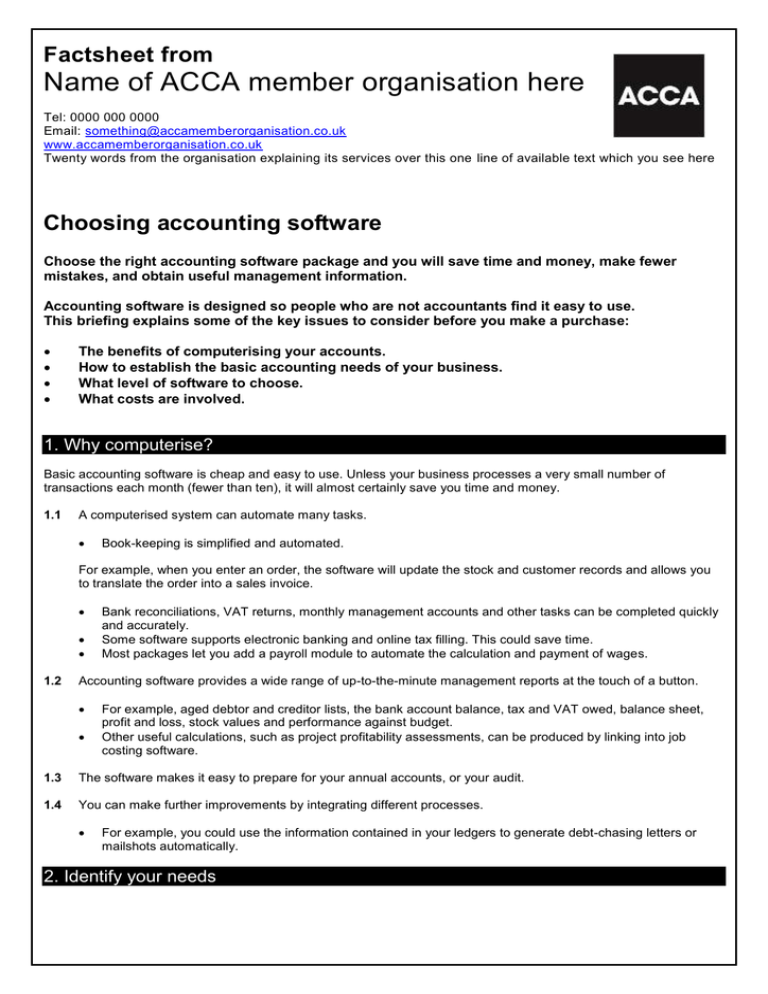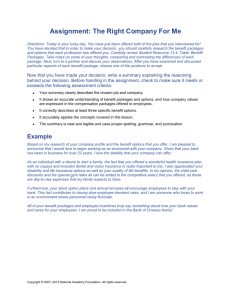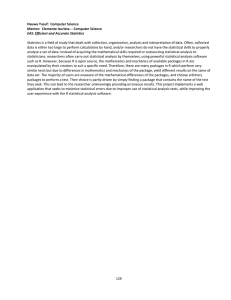
Factsheet from
Name of ACCA member organisation here
Tel: 0000 000 0000
Email: something@accamemberorganisation.co.uk
www.accamemberorganisation.co.uk
Twenty words from the organisation explaining its services over this one line of available text which you see here
Choosing accounting software
Choose the right accounting software package and you will save time and money, make fewer
mistakes, and obtain useful management information.
Accounting software is designed so people who are not accountants find it easy to use.
This briefing explains some of the key issues to consider before you make a purchase:
The benefits of computerising your accounts.
How to establish the basic accounting needs of your business.
What level of software to choose.
What costs are involved.
1. Why computerise?
Basic accounting software is cheap and easy to use. Unless your business processes a very small number of
transactions each month (fewer than ten), it will almost certainly save you time and money.
1.1
A computerised system can automate many tasks.
Book-keeping is simplified and automated.
For example, when you enter an order, the software will update the stock and customer records and allows you
to translate the order into a sales invoice.
1.2
Bank reconciliations, VAT returns, monthly management accounts and other tasks can be completed quickly
and accurately.
Some software supports electronic banking and online tax filling. This could save time.
Most packages let you add a payroll module to automate the calculation and payment of wages.
Accounting software provides a wide range of up-to-the-minute management reports at the touch of a button.
For example, aged debtor and creditor lists, the bank account balance, tax and VAT owed, balance sheet,
profit and loss, stock values and performance against budget.
Other useful calculations, such as project profitability assessments, can be produced by linking into job
costing software.
1.3
The software makes it easy to prepare for your annual accounts, or your audit.
1.4
You can make further improvements by integrating different processes.
For example, you could use the information contained in your ledgers to generate debt-chasing letters or
mailshots automatically.
2. Identify your needs
Take a ‘top-down’ approach when selecting accounting software. Outline your ideal system and decide your priorities.
This gives software suppliers a basis from which to prepare a proposal, and reduces the chance of having to make
costly changes later.
2.1
What are your business objectives?
For example, you may aim to capture ten per cent of a given market within five years, or to open ten new shops across
the UK.
2.2
Who is going to use the software?
Involve the employees who are going to be directly affected by changes you make.
What would your employees like to see in a future accounting system, and what are the limitations of your
existing system?
2.3
Fully involve your accountants from the start. Check they will be able to use the information generated by the
software to produce your end-of-year accounts and to satisfy the requirements of the annual audit.
What management information is crucial to the running of your business?
You may need to involve an accountant or outside consultant to help determine what information you will need to
extract from the system.
2.4
For example, a retailer needs instant access to stock information, while a hotel will want to know about
occupancy rates.
A consultant may be able to identify new ways in which you can use your financial data to improve your
business.
Can the software handle all the book-keeping tasks you need it to perform?
These might include:
2.5
Sales, invoicing and receipts.
Purchases and payments.
Banking and cash management.
VAT, tax and accounts.
Stock control and payroll.
What special needs does your business have?
For example, do you have more than one business, or trade internationally?
If you run an online business, can the software integrate with your e-commerce solution?
If you buy and sell in different countries, check that the software can cope with the currencies you deal in.
3. Ease of use
When purchasing software, the main trade-off is between ease of use and functionality.
3.1
Can the software interface be tailored to suit your needs?
Features to look for include:
The ability to add new fields and controls.
For example, do you want your sales ledger to contain additional information, such as the name and contact
details of the person who placed the order?
2
The option to set defaults for fields.
For example, do you want your payroll software to add a list of standard benefits automatically each time a new
employee’s details are entered?
The option to define a range of values.
For example, can you minimise data entry errors by defining entries in advance?
The option to customise screens.
For example, do you want the screen layout to look like your working documents?
3.2
Can you paste in information from other programs?
This saves time and allows you to make the best use of all your software.
Ensure you can import and export information between the accounting package and any word processing
packages, spreadsheets and databases.
4. Flexible information
4.1
Start by looking at how the software handles sales and purchase transactions.
Most software provides these functions in the form of a sales and purchase ledger.
4.2
Can you input detailed information on your customers and suppliers?
How flexible is the structure of the nominal ledger?
Most accounting software is constructed around the nominal ledger, which brings together your assets, liabilities,
income and expenses. A ledger with a flexible structure allows you to define the best accounts structure for your
business.
Can you categorise different items according to departments or cost centres?
More flexible systems allow you to define how your accounts are allocated.
Can you structure the order in which your asset, liability, income and expense accounts appear?
Simple systems require items to appear in the order in which they would appear on the balance sheet or profit
and loss account.
4.3
Does the software allow you to input a full range of transactions?
What budgeting facilities does the ledger allow for?
Can you generate separate ledgers to track specific pieces of information?
The more flexible the software is, the more you can tailor it to your business. This can make a major difference to
the overall usefulness of the software.
Will your accountant be able to use the reports to prepare year-end information?
5. The options and costs
Your greatest costs are likely to be incurred in setting up the system and training your employees to use the software.
5.1
Sole traders with simple book-keeping needs may be able to use ‘money management’ software.
Well-known packages include Microsoft Money Plus and Simply Books.
Remember that these packages may be designed for managing personal finances and often have limited
business capabilities.
3
5.2
Accounting packages have been developed to meet the needs of most small businesses.
5.3
More advanced accounting packages come in modules, with each module handling one aspect of financial
management (eg sales ledger).
5.4
Well-known packages include Sage Instant Accounts and Sage 50, Intuit QuickBooks SimpleStart and
QuickBooks Pro, Mamut One and Microsoft Money Plus Home & Business.
Well-known packages include Sage 200 and Pegasus Opera. Most businesses use at least three modules
(sales, purchase and nominal ledger).
Multi-user networked systems demand more computing power than single-user systems.
Check your existing hardware can run the packages you are considering.
Updating your IT and accounts systems at the same time will be expensive.
5.5
You may want to consider a hosted accounting package.
5.6
A hosted package runs on a server operated by another company. You pay a regular fee to access the
software over the Internet.
There are no upfront costs and management costs are lower as the hosting company takes care of the
infrastructure and technical support.
Hosted packages allow you to access your data anytime, anywhere and make it easier to collaborate with
your accountant or advisors.
However, your company’s financial data resides outside your business, so you need total confidence in the
hosting company.
Hosted accounting applications have evolved significantly and with the advent of broadband have increased
in availability and popularity.
The number of companies using SaaS (Software as a Service) systems has trebled in the past year and now
represents approximately 10 per cent of the total market for accountancy software used.
Hosted packages include Kashflow, Xero and accountsIQ.
Look for accredited software.
5.7
Most Windows packages need at least 256Mb of RAM and 500Mb free disk space on a 1GHz processor.
The Institute of Chartered Accountants in England and Wales maintains a list of accredited accounting
software. Visit www.icaew.com for more information.
Different users will need different amounts of training.
The person responsible for managing your accounts will need a more detailed understanding of how the
system works.
Employees responsible for particular functions need to be able to perform those tasks only.
For example, a sales person may only need to know how to raise an invoice.
5.8
Thorough training can be costly, but is far less expensive than learning by trial and error.
Maintenance and support are key aspects to consider when purchasing your software.
You may need to pay an annual fee to receive ongoing technical support.
You may need to update the software from time to time.
Ask about the vendor’s track record in providing support for older systems.
You may need to upgrade your computer system periodically.
4
Using a hosted package will reduce maintenance and support costs considerably.
6. Making a purchase
You may need to shop around for advice. Find someone who understands the needs of your business and also
understands the capabilities of different software packages.
6.1
Most accountants can advise businesses on what software to choose. But some are far more experienced than
others.
Your own accountant may not have experience of a sufficiently large number of software packages.
Accountants may be primarily interested in how well the software tracks transactions, which makes auditing
easier. You will also be interested in the possibility of obtaining management information that will help you
run your business more effectively.
Some firms of accountants are software resellers (see 6.2). They will have IT departments dedicated to
accounting and other software.
6.2
Most software is purchased through resellers, which can provide expert advice on the products they sell.
Does the reseller supply businesses similar to yours?
For example, an advertising agency with specialised billing requirements may prefer a supplier with experience in
dealing with such needs.
What is the reseller’s track record in providing support and training?
Ask if you can speak to businesses it has supplied about their experiences.
Many resellers are also software developers. They can customise the software to meet your exact needs.
Ensure the benefits of having a system customised will outweigh the costs.
6.3
Resellers can also give you advice about your IT requirements.
Remember that advice from a reseller is likely to favour the packages they offer. You may wish to seek
impartial advice.
Be wary of any software which does not already have a large ‘installed user base’.
A large user base removes a significant element of risk. It usually indicates an established product with
better support and more investment in upgraded versions of the software.
Compliance
The simplest accounting packages are easy to use and often look more attractive. But they may not provide you with a
sufficiently high level of compliance.
A.
Check that the software provides an audit trail.
You must be able to track all transactions that occurred during the year.
For example, the software should allow you to delete an incorrect entry, but should also retain this information for
you to check if necessary.
The software should conform to good accounting practices.
For example, an invoice should remain open in the next accounting period if you have only received part
payments.
B.
Check how the software manages the back-up procedure.
5
The software should ensure that you do not accidentally revert to using old data.
You should be able to keep records as long as required.
For example, most account information needs to be kept for six years and most payroll information for three
years.
If you use an accountant or a consultant, a good brief is vital.
Experts’ quotes
“Software as a Service (SaaS) is a compelling model for acquiring, using and paying for accounting software. It is fast
to implement and offers low upfront costs. No large initial outlay of capital is required to license the software and the
solution is typically purchased on a per-user, per-month basis, easing the burden of licensing software.”
William Parker,
UK country manager, accounts IQ
Expert contributors
Thanks to William Parker (UK country manager, accountsIQ, 00 353 1 7074481).
Further Help
Last reviewed 01.02.11
© BHP Information Solutions 2011. ISSN 1369-1996. All rights reserved. No part of this publication may be reproduced or transmitted without the
written permission of the publisher. This publication is for general guidance only. The publisher, expert contributors and distributor disclaim all liability
for any errors or omissions. Consult your local business support organisation or your professional adviser for help and advice.
6

![[CH13] SoftwareQuality](http://s2.studylib.net/store/data/014618629_1-b88eee4ce4012c6843cb089f27697697-300x300.png)



